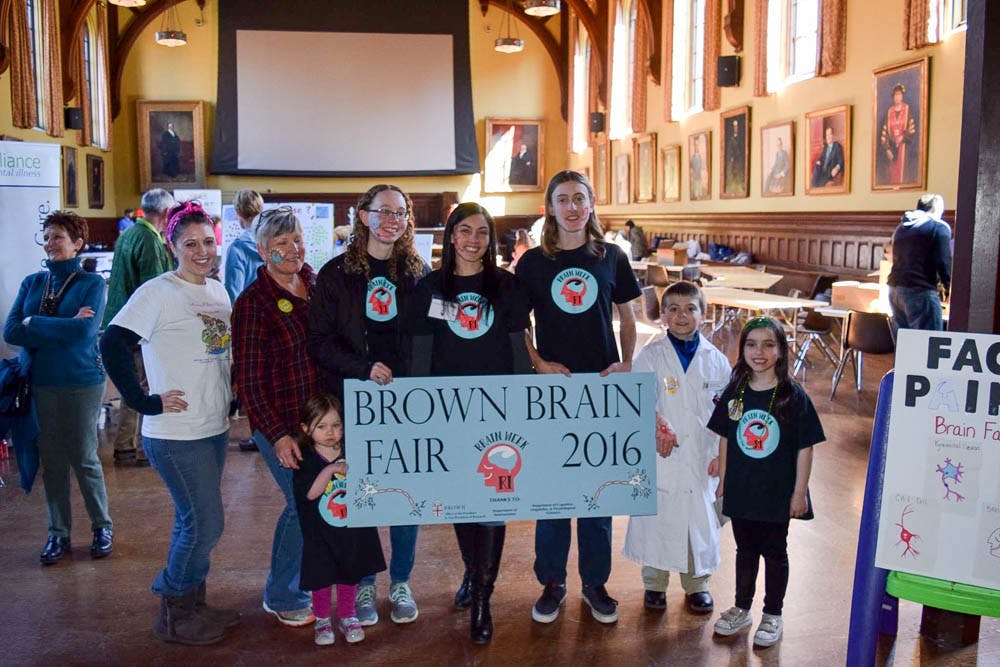If science, technology, engineering and mathematics suffer from a deficit of interest, Brown’s Brain Fair in Sayles Hall proved otherwise. The March 19 event was attended by over 500 people ranging from faculty members to local children — many of whom sported purple and pink neurons painted on their cheeks.
The fair was the climax of Brain Week Rhode Island, the first of what organizers hope will become an annual celebration of the “wonder of the brain,” according to the event website.
“I don’t expect everyone who came to the fair … to study neuroscience, but I hope they gained confidence in themselves as scientists. I think it’s good to expose people early,” said Carin Papendorp ’17, one of the student organizers of the fair. Papendorp added that the fair also has practical goals, like encouraging people to wear helmets. “We want you to protect your brain and appreciate your brain,” she said.
The fair featured booths from 28 different groups including University labs that research infant brains and neurological disorders, student clubs such as the Brown University Relaxation Group and the Brown Alzheimer’s Activists and community organizations offering everything from autism education to brain-inspired art.
Papendorp and the other organizers asked each group to create a booth that would be “relatable to the general public,” she said. The results were not only brain-shaped lollipops and make-your-own stress balls, but also tables where microscopes offered glimpses at zebrafish neurons and computer monitors showed images of different brain structures.
There were also groups that really put participants’ frontal cortices to work. The Jaworski lab, which studies the growth of the nervous system during embryonic development, asked students to pin the growth cone on the bicep — a classic children’s game, brain-ified.
As embryos develop, neurons send out structures called growth cones, which tell the rest of the cell which direction to grow, said Zack DeLoughery GS, who works in the Jaworski lab. To expose students to this process, DeLoughery blindfolded participants and asked them to use physical cues to feel their way around the board — just as growth cones respond to chemical signals — and pin the “growth cone” in its proper place.
“The kids are having a ton of fun with it,” DeLoughery said. “Some of them are coming up to play four or five times.”
Even if second graders didn’t walk away with a full understanding of the complex mechanisms of neural pathways, the activities succeeded on perhaps a more important front, Papendorp said. “It’s great to have students imagining themselves studying the brain.”
“I’m going to go to my school library and get books about brains,” said Arielle Fox, a second grader from Rumford, Rhode Island who attended the fair with her cousin and grandmother.
Older participants were challenged to think about whether popular conceptions of mental illness — statements such as,“Being an immigrant increases your risk of schizophrenia” and “Shock therapy is ineffective and is no longer used” — were true or false.
At the Rhode Island Consortium for Autism Research and Treatment’s table, participants sifted through bags trying to feel the difference between rice and paper clips. What would seem to be two completely different textures are, in reality, much harder to distinguish, said Claire Walker, a senior research associate for RI-CART.
“Adults are learning that sometimes, people who are on the (autism) spectrum may have difficulties with feeling, just like it is tough to tell the paper clips from the rice,” Walker said. “So this activity gives a sense of what it feels like to be dealing with these feelings on a day-to-day basis.”
The breadth of organizations at the fair represents a growing interest in brain research in the state, Papendorp said. “Everyone is excited about making Rhode Island an epicenter of biology and science research … and specifically, brain research. We have so many great institutions here,” she said.
This gives organizers much to draw from as they look to next year’s event, Papendorp said. “I am really excited for next year because — since there are so many different ways to approach the brain — we can have a completely new slate of events.” For example, the two movies screened during the week leading up to Brown’s Braiwwn Fair addressed post-traumatic stress disorder and bipolar disorder, but next year the movies could address depression, eating disorders, epilepsy or autism. “We need a brain month!” she said.
A staple for participants, though, will be the chance to touch a brain — preserved via plastic injections — held by the neuroscience department.
“Touching the brain was a big draw for people,” Papendorp said. “It’s smaller than you would think. It could definitely fit in a cup of two hands. You think the brain is so complicated that it must be bigger.” But, just like the fair celebrating it, “there is a lot packed in there.”





